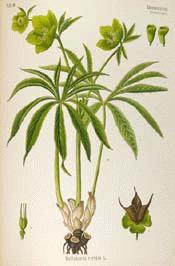
Botanical.com Home Page

|
Green Hellebore
(Helleborus viridis LINN.)
Click on graphic for larger image
|
Hellebore, Green
POISON!
Botanical: Veratrum viride
Family: N.O. Melanthaceae or Liliaceae
---Synonyms---American Hellebore. Swamp Hellebore. Indian Poke. Itch-weed.
---Parts Used---Dried rhizome and roots.
---Habitat---Swamps, low grounds, and moist meadows of the United States.
---Description---For commercial convenience, the roots are usually broken into small pieces or fragments, but are sometimes sliced, the cut surface being of a dingy white colour, or whole, the outside dark brown, with characteristic markings. Often, portions of the dried stem or leafstalks remain attached, and these, being inert, should be rejected.
American Hellebore closely resembles the German Veratrum album, or White Hellebore, and the Mexican V. officinale, or Sabadilla (Cevadilla), N.O. Liliaceae. The name Veratrine is given to the mixture of bases obtained from Sabadilla by extracting with alcohol, distilling off the alcohol, and precipitating the mixed bases with ammonia. Official in the Pharmacopoeia of 1898. The British Pharmacopoeia Codex preparation is Oleinatum Veratrinae.
---Constituents---It has been found that the alkaloids contained in V. viride are not the same as the veratrine contained in V. album and the seeds of Sabadilla. The principal alkaloids are Pseudojervine, Rubijervine, Jervine, Cevadine, Protoveratrine, and Protoveratridine. The last is probably a decomposition product, it is highly poisonous, and sternutatory. Starch and resin are also present.
---Medicinal Action and Uses---Emetic, diaphoretic, sedative, highly poisonous. The German White Hellebore, resembling the American, but without its cevadine, is rarely given internally, but the powder has been used in preparing an ointment for itch.
Veratrine, a pale grey amorphous powder, is used externally as an analgesic, and also as a parasiticide. It is not known to affect the living blood but when the latter is drawn, veratrine kills the white corpuscles. Violent pain and irritation are caused if it is given internally or subcutaneously. It prolongs the contractions of heart and muscles. Its only justifiable use is as an anodyne counter irritant, especially for neuralgia. It was emphatically decided a few years ago that V. viride should whenever possible be used instead of the European V. album, which is more likely to upset the intestines. The various alkaloids present act in very different manners, and none in exactly the same way as the whole drug - jervine, for example, is less poisonous than the drug itself, while protoveratrine, although present in small quantity, is extremely toxic.
A moderate dose of veratrum produces a reduction in the rate of the pulse, with a fall in the arterial pressure. There may be slowing of respiration. It has been used in the treatment of pneumonia, peritonitis, and other sthenic fevers, but is chiefly useful in chronic diseases, such as arterio-sclerosis and interstitial nephritis. It differs from digitalis in that it diminishes cardiac tone, and has been used for threatened apoplexy and 'irritable heart'; also for puerperal eclampsia.
Sabadilla is the principal ingredient of the pulvis capocinorum, sometimes used in Europe for the destruction of vermin in the hair.
[Top]
---Dosages---V. viride, from 1 to 3 minims of the fluid extract every two or three hours until pulse rate is reduced. 1 to 2 grains. Of U.S. tincture, 10 to 30 minims.
V. album, 1 to 2 grains in powder. Rarely given internally.
Veratrine, 1/30 grain.
---Poisons, if any, and Antidotes---Causes vomiting, with much nausea and retching. Pulse slow, later, rapid and irregular. Prostration, perspiration, pallor, with shallow and sometimes stertorous breathing.
If there is vomiting, two glasses of water should be given and 20 grains of tannic acid as an imperfect chemical antidote. Should vomiting not occur, it must be provoked, or a stomach pump employed. The patient must be kept in a horizontal position, not even being allowed to sit up to vomit. To stop the vomiting a counter-irritant must be used over the epigastrium and morphine employed very cautiously. In the early stages, when the pulse is low, atropine is very valuable, or active respiratory stimulants, such as hypodermic injections of ammonia and strychnine. If the bodily temperature is low, heat can be applied externally.
See:
BEARSFOOT (STINKING HELLEBORE) BEARSFOOT (BRITISH)
SABADILLA
HELLEBORE, WHITE
[Top]
Common Name Index
A MODERN HERBAL Home Page
Bear in mind "A Modern Herbal" was written with the conventional wisdom of the early 1900's. This should be taken into account as some of the information may now be considered inaccurate, or not in accordance with modern medicine.
© Copyright Protected 1995-2025 Botanical.com
|

